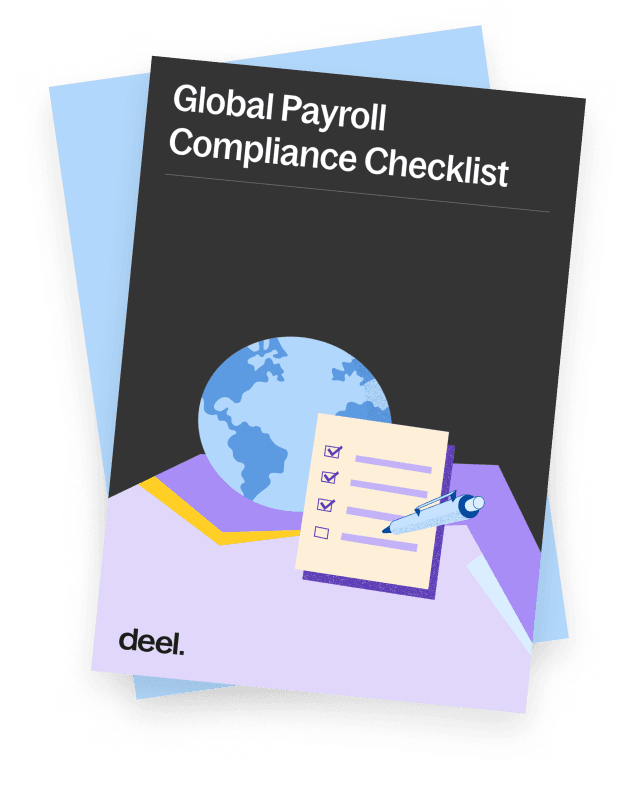Remote Work Glossary
- Results for "undefined"
Table of Contents
What is shadow payroll?
Why shadow payroll matters
When to use shadow payroll
How shadow payroll works: Step-by-step process
Run payroll compliantly on a global scale
What is shadow payroll?
What is shadow payroll?
Shadow payroll is a parallel system used to track tax and income obligations in an employee’s home and host country while working internationally.
Shadow payroll is used to:
- Calculate gross income, deductions, and taxes for both the home country (where the employee is paid and officially employed) and host country (where the employee has been sent to work temporarily)
- Track income obligations and report to tax authorities in the host country
- Ensure proper withholding for tax, social security, and compliance requirements
While the employee is still paid through their home country, shadow payroll records the financial impact in the host country, preventing double taxation and keeping compliance transparent.
Why shadow payroll matters
Global mobility programs provide career development opportunities by allowing employees to relocate to and work in different countries. However, multiple countries means multiple tax regulations, so running shadow payroll ensures compliance, tax equalization, and data consistency.
Ensure tax and compliance accuracy
Governments often require residents to report earnings regardless of where they earn income. Shadow payroll ensures that earnings, tax withholdings, and contributions are recorded and reported correctly in the employee’s home and host country.
Some countries do not require employers to withhold income tax and social security contributions. In this case, running shadow payroll is not required, but this exception further proves the importance of staying updated with country-specific regulations.
Maintain tax equalization
Tax equalization is a payroll policy that protects international employees from being taxed more or less than necessary. With shadow payroll, companies can apply tax treaties and credits, ensuring employees don’t pay taxes twice on the same income.
Under a tax equalization policy, employers pay any extra tax burden that applies to an employee during an international assignment. This enables employees to continue paying the same tax rates that they would while working in their home country.
Preserve data consistency and visibility
Shadow payroll provides HR, finance, and legal teams with complete visibility into how international assignments affect an employee’s payroll. Maintaining accurate payroll data and payroll visibility is useful for budgeting, compliance planning, and audits.

When to use shadow payroll
Shadow payroll is commonly used for expatriate assignments, remote workers, and tax compliance needs.
Expatriate assignments
Shadow payroll is essential for expatriate employees to ensure their tax, social security, and benefit obligations are tracked and reported while they are working in the host country. This parallel reporting supports compliance with tax regulations and benefits contributions.
Virtual assignments
Virtual employees perform tasks for companies online, often from a remote location or outside the employer’s country. Due to multiple countries involved in virtual assignments, running shadow payroll may be necessary to ensure all tax and income obligations are met compliantly.
See also: How to Pay Remote Workers in Multiple Countries
Tax compliance needs
Whenever tax authorities require income reporting on foreign assignments, shadow payroll provides a transparent record, avoids double taxation, and ensures both the company and employee meet all legal obligations.
How shadow payroll works: Step-by-step process
Here’s a step-by-step look at how to implement shadow payroll.
1. Determine assignment type and duration
Assess whether the employee is on a short-term assignment (under a year, typically visa-dependent) or a long-term relocation. This determines the need and scope of shadow payroll.
2. Start running shadow payroll for the host country
Employees working abroad are still paid from their home country, and a simulated payroll is run for the host country. This mirrors calculations such as gross pay, taxes, social security, and employer contributions for compliance purposes.
3. Tax withholding and remittance
Although no real funds flow through shadow payroll, taxes and contributions owed are reported and remitted to host-country tax authorities. This may involve setting up shadow payroll in-house or outsourcing to a global payroll provider.
4. Integration with tax equalization policies
Many companies equalize tax burdens so employees pay only what they would have paid in their home country. Shadow payroll enables full transparency and accurate adjustment for tax equalization.
5. Reporting and compliance documentation
Shadow payroll records feed into tax filings, social security returns, and audit documentation, providing a complete compliance picture.
Run payroll compliantly on a global scale
Partnering with a global payroll expert helps you understand the nuances of shadow payroll and balance multiple country-specific tax regulations efficiently and accurately.
Deel Payroll makes this possible by automating compliance monitoring and providing support through 2,000+ in-house experts in payroll, HR, and legal—all in one unified platform.
Request a demo to learn more about how Deel can help your business manage shadow payroll and stay updated on local regulations, no matter where your employees are.
